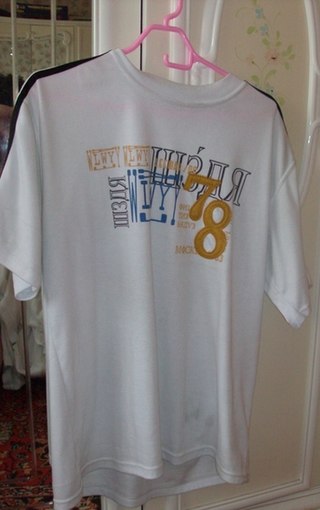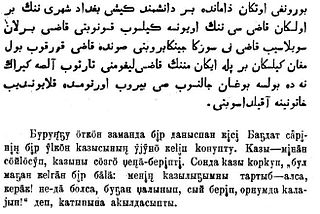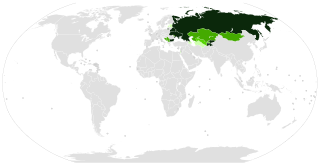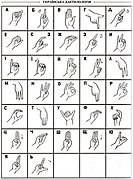- Ukrainian Manual Alphabet (UMA), post 2003. Differs from Soviet type of UMA in that it has all letters of Ukrainian Alphabet present (Ї, Ґ etc).
- Soviet type of Ukrainian Manual Alphabet (UMA), used prior to 2003. Differs from the UMA used in independent Ukraine in that it lacks some letters of Ukrainian Alphabet present (Ї, Ґ etc).
Related Research Articles

The Cyrillic script, Slavonic script or the Slavic script, is a writing system used for various languages across Eurasia. It is the designated national script in various Slavic, Turkic, Mongolic, Uralic, Caucasian and Iranic-speaking countries in Southeastern Europe, Eastern Europe, the Caucasus, Central Asia, North Asia, and East Asia.

Ghe with upturn, also known as G, is a letter of the Cyrillic script. It is part of the Ukrainian alphabet, the Pannonian Rusyn alphabet and both the Carpathian Rusyn alphabets, and also some variants of the Urum and Belarusian alphabets. In these languages it is usually called ge, while the letter it follows, ⟨Г г⟩ is called he. In the Unicode system for text encoding, this letter is called ghe with upturn.

The Ukrainian alphabet is the set of letters used to write Ukrainian, which is the official language of Ukraine. It is one of several national variations of the Cyrillic script. It comes from the Cyrillic script, which was devised in the 9th century for the first Slavic literary language, called Old Slavonic. Since the 10th century, it became used in the Kyivan Rus' for Old East Slavic, from which the Belarusian, Russian, Rusyn, and Ukrainian alphabets later evolved. The modern Ukrainian alphabet has 33 letters in total: 20 consonants, 2 semivowels, 10 vowels and 1 palatalization sign. Sometimes the apostrophe (') is also included, which has a phonetic meaning and is a mandatory sign in writing, but is not considered as a letter and is not included in the alphabet.

Faux Cyrillic, pseudo-Cyrillic, pseudo-Russian or faux Russian typography is the use of Cyrillic letters in Latin text, usually to evoke the Soviet Union or Russia, though it may be used in other contexts as well. It is a common Western trope used in book covers, film titles, comic book lettering, artwork for computer games, or product packaging which are set in or wish to evoke Eastern Europe, the Soviet Union, or Russia. A typeface designed to emulate Cyrillic is classed as an ethnic typeface.

The Belarusian alphabet is based on the Cyrillic script and is derived from the alphabet of Old Church Slavonic. It has existed in its modern form since 1918 and has 32 letters. See also Belarusian Latin alphabet and Belarusian Arabic alphabet.

Three alphabets are used to write the Kazakh language: the Cyrillic, Latin and Arabic scripts. The Cyrillic script is used in Kazakhstan and Mongolia. An October 2017 Presidential Decree in Kazakhstan ordered that the transition from Cyrillic to a Latin script be completed by 2025. The Arabic script is used in Arabia, Iran, Afghanistan and parts of China.
The grammar of Ukrainian describes its phonological, morphological, and syntactic rules. Ukrainian has seven cases and two numbers for its nominal declension and two aspects, three tenses, three moods, and two voices for its verbal conjugation. Adjectives agree in number, gender, and case with their nouns.

There are 4 stages in the history of Yakut writing systems:
The Ukrainian orthography is orthography for the Ukrainian language, a system of generally accepted rules that determine the ways of transmitting speech in writing.

Numerous Cyrillic alphabets are based on the Cyrillic script. The early Cyrillic alphabet was developed in the 9th century AD and replaced the earlier Glagolitic script developed by the Byzantine theologians Cyril and Methodius. It is the basis of alphabets used in various languages, past and present, Slavic origin, and non-Slavic languages influenced by Russian. As of 2011, around 252 million people in Eurasia use it as the official alphabet for their national languages. About half of them are in Russia. Cyrillic is one of the most-used writing systems in the world. The birth place of the Cyrillic alphabet is Bulgaria. The creator is Saint Clement of Ohrid from the Preslav literary school in the First Bulgarian Empire.

This is a summary of the use of Morse code to represent alphabets other than Latin.
JCUKEN is the main Cyrillic keyboard layout for the Russian language in computers and typewriters. Earlier in Russia JIUKEN (ЙІУКЕН) layout was the main layout, but it was replaced by JCUKEN when the Russian alphabet reform of 1917 removed the letters Ѣ, І, Ѵ, and Ѳ. The letter Ъ had decreased in usage significantly after the reform.

Russian Braille is the braille alphabet of the Russian language. With suitable extensions, it is used for languages of neighboring countries that are written in Cyrillic in print, such as Ukrainian and Mongolian. It is based on the Latin transliteration of Cyrillic, with additional letters assigned idiosyncratically. In Russian, it is known as Шрифт Брайля.
Ukrainian Braille is the braille alphabet of the Ukrainian language. It is based on Russian Braille, with a few additional letters found in the print Ukrainian alphabet.
Yaryzhka or Orthography of Slobozhanshchyna is the name of the Russian pre-revolutionary orthography used to write and print works in the Ukrainian language in the Russian Empire. Yaryzhka included all the letters that were part of the Russian Cyrillic alphabet of the pre-revolutionary period: ы, ъ, and so on.
The Komi language, a Uralic language spoken in the north-eastern part of European Russia, has been written in several different alphabets. Currently, Komi writing uses letters from the Cyrillic script. There have been five distinct stages in the history of Komi writing:
Since its inception in the 18th century and up to the present, it is based on the Cyrillic alphabet to write the Udmurt language. Attempts were also made to use the Latin alphabet to write the Udmurt language. In its modern form, the Udmurt alphabet was approved in 1937.

Orthography of Smal-Stotskyi and Gartner, also Orthography of Smal-Stotskyi and ScientificOrthography is a Ukrainian orthography created on the basis of Zhelekhivka by Stepan Smal-Stotskyi in collaboration with Theodor Gartner. One of the main innovations of spelling was that the authors also adapted Zhelekhivka for foreign words. In 1891, under the pseudonym Stepan Nahnybida, Smal-Stotskyi published a description of his spelling principles in a 16-page pamphlet On Ruthenian Orthography. In 1893, Smal-Stotskyi and Gartner published the Ruthenian Grammar, which listed all the phonetic rules of this spelling in practice.
The Ukrainian orthography of 1933 is the Ukrainian orthography, adopted in 1933 in the capital of the UkrSSR, Kharkiv. It began the process of artificial convergence of Ukrainian and Russian language traditions of orthography. Some norms that were rejected due to their absence in the Russian orthography were returned to the Ukrainian orthography of 2019.
Khakass alphabets are the alphabets used to write the Khakas language.
References
- ↑ Кульбіда С. В. Українська дактилологія: науково-методичний посібник. — с. 115

